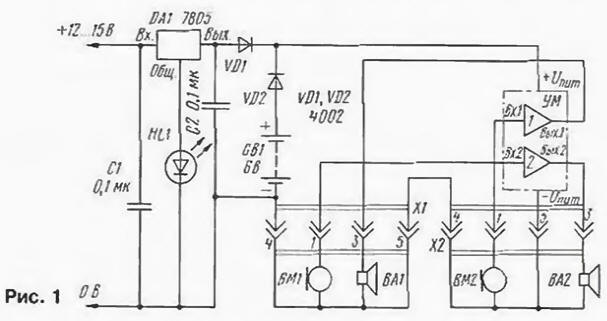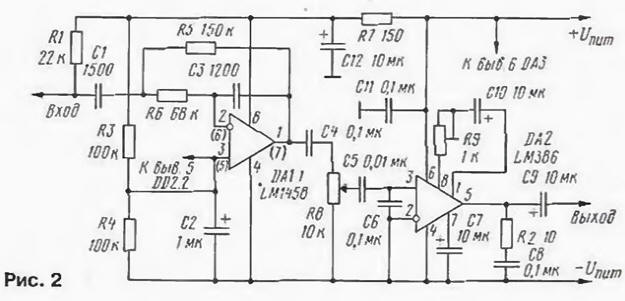A normal conversation between the driver and passenger of the motorcycle while driving only possible with the special communicators - the intercom.
The analysis of the noise generated by the movement of the motorcycle, showed that the bulk of their acoustic impact lies in the low frequency region (from engine - to about 500 Hz) and high frequencies from powerful oncoming air flow - above 3 kHz). Therefore, when designing the device for the intercom was paid a large attention to the creation of a bandpass filter with a bandwidth in the range from 600 Hz to 3 kHz. The device incorporates a combined bandpass filter having a recession Frequency response 18 dB/octave in the high-frequency and 6 dB/octave in the low-frequency part.
Schematic diagram of the device shown in Fig. 1.

In Fig. 2 is a diagram one of the two channels of amplification. The second channel is made identical. Sound the signal from the microphone WM (Fig. 1) via the capacitor C1 is supplied to an inverting the input circuit DA1.1. The second half of the chip (the numbering of its findings indicated in parentheses) used to build a similar cascade of the second channel the intercom.

The cutoff frequency of the second filter is defined by the elements R5, R6. C3 and C4, and the divider the voltage on the resistors R3 and R4 creates the necessary offset the positive input when powered from a single power source.
Power amplifier audio frequency (USC) in each channel is executed on a separate chip (DA2 indicated on the diagram of the channel). Optimal amplification (in depending on the individual characteristics of the hearing of the driver and passenger and conditions road conditions when driving) set variable resistor R8 and rigged R9.
The capacitor C6 together with elements C8 and R2 provide stability work USC. Elements Of C7. C11, C12 R7 and prevent unwanted feedback nutrition.
The food chain (Fig. 1) is constructed so as to be able to use any type of current source is a galvanic battery of four AA batteries or batteries of the same size and on-Board battery or a generator. To separate the influence of sources introduced diodes VD1 and VD2. When powered from the on-Board network for motorcycle noise suppression, including pulse, the voltage is fed through the intercom integrated stabilizer DA3. In the circuit total bus power stabilizer steady light HL1. This stabilizer provides the output voltage 6.5...7 V. therefore, the source side will be dominant even with a fresh battery GB1.
A pair of microphone-speaker for the driver and passenger are located in individual crash helmets. For each of the pairs used standard peristeria connectors from the sound reinforcement equipment. Conclusion 5 block portion connector X1 is connected to pin 4 of connector x2. This is the circuit common power bus. So, if you are a motorcycle stop otstykovyvatsya one of these connectors, the entire system is de-energized. It is a kind of protection from wastage of energy.
In Fig. 1 also shows that the microphone VM connected to the second channel of the amplifier), and the microphone VM - to the first, it creates a cross connection of the driver and the passenger.
The adjustment device is recommended to start when working from the electrical system of the motorcycle. Turn the regulator voltage in the range 12... 15 V and at its output check the voltage - it should be about 6.5 In (measured between the anode VD1 and a common power bus or the negative terminal of the battery connection 1 GB). Current consumption in silent mode both operators should not exceed 5 mA.
Dual operational amplifier LM1458 contains in one case two 0УμА741 (a complete analog - UD). Here you can apply other single or dual The OS (for example. CRUD). The node on the chip DA2 can be substituted for chip CAN in its inclusion model, and integrated stabilizer - CREA. Diodes VP1 and VD2 can be CD SA.
The microphone capsule - electret type FEM-3. as the speaker can use a sound dynamic heads with a capacity of 0.1...0.5 W with the resistance of the voice coil 8 Ohm - 0,25 GDS-3, 0,5 GDS-1.
Author: G. Cattley






